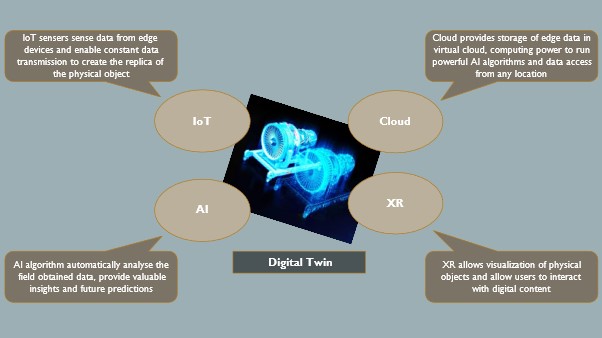Digital Twin
It is not a new trend since NASA had used first mock-up in the 1960s during their space mission Apollo 13 to replicate the physical systems present in aircraft at ground for troubleshooting and maintenance. In 2002, Dr. Michael Grieves first used the term Digital Twin. It is a virtual representation of physical assets, operational processes, people, or places. It shows the visualization of complex assets and processes and helps businesses to improve their performance. Digital Twin can perform bi-directional automated data flow between the physical object and digital representation.
Digital Twin embraces four technologies to create visual representation, capture, store, analyse data and provide valuable insights. These technologies are the IoT, Extended Reality (XR), Cloud, and Artificial Intelligence (AI).

Benefits
Major benefits of Digital Twins include remote visibility of assets, systems, processes, and understanding the behaviour of physical device. With asset behaviour insights, it runs prediction algorithm to predict the future. Also, these insights aid better decision making and automate the decision-making process, optimising productivity, and profitability. Additionally, it also performs risk analysis on different what-if scenarios and help businesses to maximise operational efficiency. Comparing Digital Twin with Digital Simulation, simulation is static and does not update in real-time, while Digital Twin is dynamic and get real-time updates from physical asset, system, or process. Thus, it produces more accurate outputs for business decisions.
Digital Twin has extensive applications in various industries like Healthcare, Manufacturing, Automotive, Utilities and Smart City. Gartner predicts that by 2021, approx. 50% of large companies will utilize digital twins and improve their internal efficiency by 10%. Also MarketsandMarkets researched, The Global Digital Twins in Healthcare Market in terms of revenue was estimated to be worth $1.6 Billion in 2023 and is poised to reach $21.1 billion by 2028
Let us look at few Digital Twin use cases in the medical domain.
Patient Digital Twin – Enabling Personalised Care
Patient’s Digital Twin is designed to capture continuous data from the individual about various vitals, medical condition, response to the drug, therapy, and surrounding ecosystem. Each patient’s data is stored at Azure or AWS public cloud and fed to the Digital Twin platform. Historic and real-time data of each patient helps ML algorithm to predict future health conditions. With lifestyle, daily food habits and blood sugar data of chronic diabetes patient, model alerts the patient for medications, food habit changes, doctor consultation etc. Thus, Digital Twin leverages a large amount of rich data from various IoMT devices and uses AI-powered models to develop more personalized and better care plans.
Unique Digital Twin from each patient help in determining right therapy, predict the outcome of a specific procedure and manage the chronic disease for them using insights from historical data. Consider a scenario of heart failure patient who needs a Cardiac Resynchronization Therapy (CRT) by implanting a pacemaker. Due to different heart characteristics, few patients do not respond to the therapy. Also, for the right patients, the placement must be precise to avoid future risks. By leveraging patients MRI, ECG and Blood Pressure data, Digital Twin of the patient heart is created, and it helps cardiologists to define the position of leads and virtually experimenting the placement before intervention surgery.
Another example is right therapy decision support for cancer treatment. Digital Twin with patient’s imaging data, genetic data and laboratory results helps the doctor to decide optimum treatment from surgery, radiation therapy or hormone therapy. To manage chronic disease in a large population, Digital Twin helps in detecting chronic disease in an earlier stage by analysing physiological and behavioural data.
Hospital Digital Twin – Improving Operational Efficiency
Initially, Digital Twin was limited to a single device or component but with emergence in Artificial Intelligence (AI) technology, Digital Twin now has evolved and can represent an entire complex system, process, or place. Digital Twin of various hospital business processes helps in optimizing and improving the entire ecosystem. It models so many dimensions of hospital facility including the movement of doctors, patients, equipment and with real-time location tracking of systems, assets, and people. Using real-time data availability from entire hospital data points, the AI model can simulate the improved efficiency. The model algorithm can consolidate the results from imaging and non-imaging laboratory diagnosis and can present results which help the physician to make a better decision.
Siemens Healthineers created Digital Twin model representation for radiology department of one of the customers after analysing their process and operations. Such simulation optimizes the process and improves the patient experience by reducing long wait times, effectively managing emergency services, optimum utilization of lab and medical equipment, staffing requirement and managing devices downtime. Thus, hospital management can monitor the entire infrastructure from a unified platform – patient to clinicians to data to workflows.
Simulated Training
The idea of Digital Twin in medical training and diagnostics is a patient model created before actual surgery and virtual surgery is performed from the multidisciplinary team on it to avoid damage of human anatomy. This real-time model also allows residents to do surgery simulation on patients and help them to understand each patient’s physiological and anatomical differences. One of the examples of diagnostics using Digital Twin model is CardioInsight mapping system from Medtronic which collects and combines the patient body surface electrical data with heart-torse anatomical data and provide a 3D map of heart’s electrical activity. This diagnostics method has also received an approval from the FDA.
Future Prospects and Challenges in Implementing Digital Twins in Healthcare
Future Prospects:
As the healthcare sector advances, the integration of Digital Twin technology holds significant promise for further progress. Here are key areas of future potential:
Genomic Digital Twins: Expanding beyond current applications, Digital Twins could delve into genomics, creating personalized genomic representations. This has the potential to revolutionize precision medicine by tailoring treatments based on an individual’s genetic makeup.
Interoperability and Standardization: Future developments may witness increased efforts to standardize Digital Twin models, ensuring seamless interoperability between different healthcare systems. This could lead to a more unified and collaborative approach to patient care.
Telemedicine Integration: With the rise of telemedicine, Digital Twins could play a crucial role in enhancing remote patient monitoring. Integrating Digital Twins with telehealth platforms could enable more comprehensive and real-time virtual healthcare services.
Challenges:
While the potential benefits are substantial, the implementation of Digital Twins in healthcare comes with its set of challenges:
Data Security and Privacy Concerns: The extensive use of patient data in creating Digital Twins raises concerns about data security and patient privacy. Striking a balance between utilizing valuable health information and ensuring robust data protection measures is crucial.
Standardization Hurdles: The lack of standardized practices for creating and utilizing Digital Twins in healthcare can hinder widespread adoption. Efforts to establish industry-wide standards will be vital to promote consistency and compatibility.
Integration with Legacy Systems: Many healthcare facilities still operate on legacy systems that may not seamlessly integrate with advanced technologies like Digital Twins. Transitioning from traditional systems to digital counterparts requires careful planning and strategic implementation.
Ethical Considerations: As Digital Twins become more sophisticated, ethical considerations surrounding issues like consent, transparency, and the responsible use of technology will become increasingly important. Striking a balance between innovation and ethical practices is paramount.
Final Thoughts
With the promise of personalized healthcare, remote patient monitoring, and health prediction, Digital Twin demand in the medical domain has increased significantly. Further, with Digital Twin model of the hospital, care setups, operational strategies and staffing help hospitals to optimise cost and improve patient care. eInfochips has driven digital platform enablement for global customers across industry verticals by offering consulting, design, and operations services. Contact our team today to know more about our Digital Transformation services.













